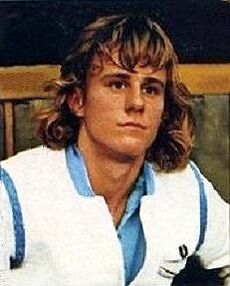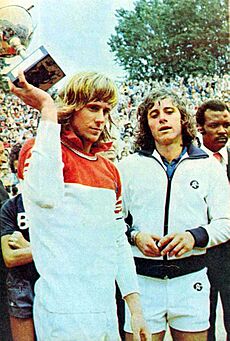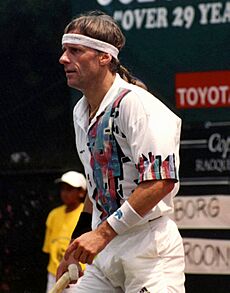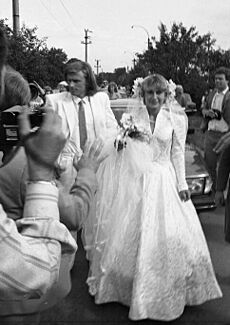Björn Borg facts for kids
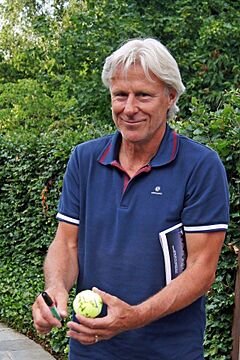
Borg in 2014
|
|
| Full name | Björn Rune Borg |
|---|---|
| Country (sports) | |
| Residence | Norrmalm, Stockholm, Sweden |
| Born | 6 June 1956 Stockholm, Sweden |
| Height | 1.80 m (5 ft 11 in) |
| Turned pro | 1973 (comeback in 1991) |
| Retired | 1984, 1993 |
| Plays | Right-handed (two-handed backhand) |
| Coach | Lennart Bergelin (1971–1983) Ron Thatcher (1991–1993) |
| Prize money | US$3,655,751 |
| Int. Tennis HoF | 1987 (member page) |
| Singles | |
| Career record | 654–140 (82.37%) (82.4%) |
| Career titles | 66 (8th in the Open Era) |
| Highest ranking | No. 1 (23 August 1977) |
| Grand Slam singles results | |
| Australian Open | 3R (1974) |
| French Open | W (1974, 1975, 1978, 1979, 1980, 1981) |
| Wimbledon | W (1976, 1977, 1978, 1979, 1980) |
| US Open | F (1976, 1978, 1980, 1981) |
| Other tournaments | |
| Tour Finals | W (1979, 1980) |
| WCT Finals | W (1976) |
| Professional majors | |
| US Pro | W (1974, 1975, 1976) |
| Wembley Pro | W (1977) |
| Doubles | |
| Career record | 86–81 (51.2%) |
| Career titles | 4 |
| Grand Slam doubles results | |
| Australian Open | 3R (1973) |
| French Open | SF (1974, 1975) |
| Wimbledon | 3R (1976) |
| US Open | 3R (1975) |
| Team competitions | |
| Davis Cup | W (1975) |
Björn Rune Borg (born 6 June 1956) is a famous Swedish former professional tennis player. He was ranked as the world No. 1 in men's singles for 109 weeks by the Association of Tennis Professionals (ATP). Borg won 66 singles titles in his career. This includes eleven major titles, with six at the French Open and five in a row at Wimbledon.
Borg was a huge star when he was a teenager. His amazing success helped tennis become super popular in the 1970s. Between 1974 and 1981, he won 11 major singles titles. This was more than any other male player in the Open Era at that time. His rivalries with Jimmy Connors and John McEnroe were very famous, even outside of tennis. The match against McEnroe in the 1980 Wimbledon final is thought to be one of the best tennis matches ever played. After losing to McEnroe in the 1981 Wimbledon and US Open finals, Borg surprisingly retired from tennis when he was just 25. He tried to play again briefly in 1991, but it was not successful.
Borg won four French Open titles in a row (1978–81). He never lost a French Open final. He is the only man to win both the French Open and Wimbledon in the same year three times. This is called the Channel Slam. He also won three major titles without losing a single set during those tournaments. However, he never won the US Open, even though he reached the final four times. Borg also won three year-end championships. In 1979, he was the first player to earn over US$1 million in prize money in one season. He set many records, and some are still unbroken today.
Many people think Borg is one of the greatest tennis players of all time. Tennis magazine ranked him as the sixth-greatest male player of the Open Era.
Contents
Early Life and Tennis Beginnings
Björn Borg was born in Stockholm, Sweden, on June 6, 1956. He was the only child of Rune and Margaretha Borg. He grew up in a town nearby called Södertälje. When he was a child, Borg loved a golden tennis racket his father won at a table-tennis tournament. His father gave him the racket, and that's how his tennis journey began.
Borg was a very athletic player with amazing stamina. He had a unique style and look. He was bowlegged and very fast. His strong muscles allowed him to hit the ball with a lot of topspin on both his forehand and his two-handed backhand. He was one of the first players to use a two-handed backhand, following Jimmy Connors. By the time he was 13, he was already beating the best Swedish players under 18. His coach, Lennart Bergelin, told everyone not to try and change Borg's unusual strokes.
Professional Tennis Career
Starting Out: 1972–1973
At just 15 years old, Borg played for Sweden in the 1972 Davis Cup. He won his first singles match in five sets. Later that year, he won the Wimbledon junior singles title. He also won the Orange Bowl Junior Championship for boys 18 and under.
Borg became a professional player in 1973. He reached his first singles final in April at the Monte Carlo Open, but he lost. He played in his first French Open and reached the fourth round. At his first Wimbledon Championships, he made it to the quarterfinal. He finished 1973 ranked No. 18 in the world.
First Major Wins: 1974–1975
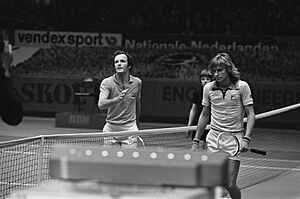
In 1974, Borg played in the Australian Open for the only time. He won his first professional singles title at the New Zealand Open. Just before his 18th birthday, he won the Italian Open. Two weeks later, he won the French Open, which was his first Grand Slam title. He was the youngest male French Open champion ever at that time.
Borg won the French Open again in 1975. He then reached the Wimbledon quarterfinals. Borg did not lose another match at Wimbledon until 1981. He also helped Sweden win the 1975 Davis Cup. He had an amazing streak of 33 consecutive Davis Cup singles wins.
Wimbledon Dominance: 1976–1980
In 1976, Borg won the World Championship Tennis (WCT) year-end finals. At the 1976 French Open, he lost to Adriano Panatta, who was the only player to ever beat Borg at this tournament. Borg won Wimbledon in 1976 without losing a single set. He became the youngest male Wimbledon singles champion since 1931. He also reached the final of the 1976 U.S. Open, but lost to Jimmy Connors. Borg was named ATP Player of the Year.
Borg skipped the French Open in 1977. But he won Wimbledon again, after a very tough five-set semifinal against his friend Vitas Gerulaitis. This win made Borg the No. 1 player in the ATP rankings for a short time. He was named "ATP Player of the Year" again.
From 1978 to 1980, Borg was at the peak of his career. He won both the French Open and Wimbledon in all three of these years. In 1978, he won the French Open without losing a set. He also beat Connors in the 1978 Wimbledon final. At the 1978 US Open, he lost to Connors in the final. Later that year, Borg played John McEnroe for the first time and lost. Borg was named ATP Player of the Year and was the first ITF World Champion.
In 1979, Borg lost to McEnroe again in a final. But he became the top-ranked player by winning his fourth French Open title and fourth straight Wimbledon title. He also won his first Masters tournament in New York. Borg finished 1979 as the No. 1 player in the world.

In 1980, Borg won his fifth French Open title, again without losing a set. He then won his fifth Wimbledon title in a row. This was against McEnroe in a five-set final that many call the best Wimbledon final ever. Borg won after a very long and exciting match. He later said this was the first time he was scared he might lose.
In September 1980, Borg reached the U.S. Open final for the third time, losing to John McEnroe in another five-set match. This match made their rivalry even more famous. Borg won his second Masters title in January 1981, beating Ivan Lendl. He finished 1980 as the No. 1 player in the world again.
Final Grand Slam and Retirement: 1981–1983
Borg won his last Grand Slam title at the French Open in 1981, beating Lendl in a five-set final. His six French Open titles were a record until Rafael Nadal broke it in 2012.
In 1981, Borg reached the Wimbledon final, extending his winning streak at the All England Club to a record 41 matches. However, McEnroe defeated him in four sets, ending Borg's amazing streak. Borg later said he wasn't even upset about losing, which shocked him. He felt his desire to play was fading.
Borg also lost to McEnroe at the 1981 US Open. After that loss, Borg left the court quickly without attending the ceremonies. The 1981 US Open was his last Grand Slam final. New rules were coming in that required players to play many tournaments each year. Borg wanted to play less, and he felt his strong drive to win was gone.
Borg never won the US Open, losing in the final four times. He also only played the Australian Open once, in 1974, when he was 17.
In January 1983, Borg announced he was retiring from tennis at just 26 years old. This was a big shock to the tennis world. McEnroe even tried to convince him to keep playing.
Life After Tennis
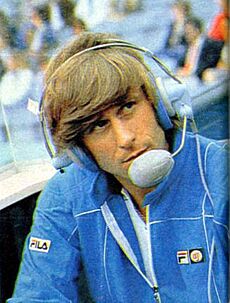
After retiring, Borg became the owner of the Björn Borg fashion label. In Sweden, his brand became very successful.
Attempted Comeback: 1991–1993
From 1991 to 1993, Borg tried to make a comeback to professional tennis. He grew his hair long again and used a wooden racket, like he did in his prime. However, he didn't win a single match. He came closest to winning in his final match in 1993, losing in a close three-set match. Later, Borg joined the Champions tour, where he used modern rackets and had more success.
Playing Style and Mental Strength
Borg had a very unique playing style. He played from the back of the court, hitting powerful shots. He used a lot of topspin on his shots, which made them very consistent. He was one of the first top players to use heavy topspin all the time.
Borg was also incredibly fit. His fitness and consistent shots made him very strong on the clay courts of the French Open. What made Borg special was his success on the grass courts of Wimbledon, where players who stayed at the back of the court usually didn't do well. Experts say his consistency, good serve, and volleys helped him adapt to grass.
Another thing people remember about Borg was how calm he was under pressure. He was so calm on the court that he was nicknamed the "Ice Man" or "Ice-Borg." Borg's physical training was better than most other players of his time. He could outlast almost anyone in tough matches. Borg is also known for helping to create the style of play that is common in tennis today.
Personal Life
Borg married Romanian tennis player Mariana Simionescu in 1980, but they divorced in 1984. He had a son named Robin in 1985. Borg was married to Italian singer Loredana Bertè from 1989 to 1993. On June 8, 2002, he married his third wife, Patricia Östfeld. They have a son named Leo, born in 2003, who is also a professional tennis player.
Borg almost went bankrupt when some of his business ideas didn't work out. He later sold his mansion and moved to an apartment in Stockholm.
Film About Borg
In 2017, a movie called Borg vs McEnroe was released. It focused on the famous rivalry between Borg and McEnroe, especially their 1980 Wimbledon final. In 2022, interviews about their friendship were also shown in a documentary called "McEnroe."
Honors and Recognition
Borg was ranked world No. 1 by the ATP for a total of 109 weeks between 1977 and 1981. He won 77 top-level singles titles and four doubles titles in his career.
He received the BBC Sports Personality of the Year Overseas Personality Award in 1979. In 1987, Borg was inducted into the International Tennis Hall of Fame. In 2006, the British Broadcasting Corporation gave him a Lifetime Achievement Award. In December 2014, a Swedish newspaper voted him Sweden's top sportsperson of all time.
With 11 Grand Slam titles, Borg is among the top male tennis players with the most Grand Slam singles titles. Winning both the French Open and Wimbledon in the same year, which he did three times in a row, is called "the most difficult double in tennis." Only a few other male players have achieved this double since Borg. Many people consider Borg to be one of the greatest players in tennis history.
Borg never won the US Open, losing in the final four times. He also did not win the Australian Open, which he only played once. The only players to beat Borg in a Grand Slam final were fellow world No. 1 players John McEnroe and Jimmy Connors.
Laver Cup Captain
From 2017 to 2021, Borg was the successful captain of Team Europe in the Laver Cup. This is a team tennis tournament where Team Europe plays against Team World, coached by John McEnroe. Borg's Team Europe won the first four editions of the Laver Cup, showing his great leadership.
Career Statistics
Singles Performance in Major Tournaments
| Tournament | 1972 | 1973 | 1974 | 1975 | 1976 | 1977 | 1978 | 1979 | 1980 | 1981 | SR | W–L | Win % | |
|---|---|---|---|---|---|---|---|---|---|---|---|---|---|---|
| Grand Slam tournaments | ||||||||||||||
| Australian Open | A | A | 3R | A | A | A | A | A | A | A | A | 0 / 1 | 1–1 | 50.00 |
| French Open | A | 4R | W | W | QF | A | W | W | W | W | 6 / 8 | 49–2 | 96.08 | |
| Wimbledon | A | QF | 3R | QF | W | W | W | W | W | F | 5 / 9 | 51–4 | 92.73 | |
| US Open | PR* | 4R | 2R | SF | F | 4R | F | QF | F | F | 0 / 10 | 40–10 | 80.00 | |
| Win–loss | 0–1 | 10–3 | 11–3 | 16–2 | 17–2 | 10–1 | 20–1 | 18–1 | 20–1 | 19–2 | 11 / 28 | 141–17 | 89.24 | |
- The Australian Open was held twice in 1977, in January and December. Borg did not play in either.
- The 1972 US Open had a special preliminary round before the main 128 player draw began.
Records
- These records were achieved in tennis history since 1877.
- Records in bold mean no one else has done them.
- ^ means a record for consecutive achievements.
All-Time Records
| Tournament | Since | Record accomplished | Players matched | References |
|---|---|---|---|---|
| Grand Slam | 1972 | 86.96% (20–3) five set match record | Stands alone | |
| Grand Slam | 1977 | 3 consecutive Channel Slams, French Open + Wimbledon (1978–80) ^ | Stands alone | |
| Grand Slam | 1978 | Grand Slam title won (1978 French Open) with fewest games lost (32) | Stands alone | |
| Wimbledon | 1977 | 92.73% (51–4) match win percentage | Stands alone | |
| Wimbledon | 1977 | 41 consecutive match wins | Stands alone |
Open Era Records
- These records were achieved in the Open Era of tennis, which started in 1968.
- Records in bold mean no one else has done them.
- ^ means a record for consecutive achievements.
| Time span | Selected Grand Slam tournament records | Players matched | References |
|---|---|---|---|
| 1976 Wimbledon — 1981 French Open |
41% (11/27) title winning percentage | Stands alone | |
| 1976 Wimbledon — 1981 French Open |
89.24% (141–17) career match winning percentage | Stands alone | |
| 1977–1981 | 5 consecutive years with a match winning percentage of 90%+ ^ | Stands alone | |
| 1978 French Open — 1978 US Open |
66.5% (380–191) games winning percentage in 1 season | Stands alone | |
| 1978 French Open | 79.9% (127–32) games winning in one tournament | Stands alone | |
| 1976 Wimbledon — 1980 Wimbledon |
6 existing Major champions defeated in finals | Roger Federer | |
| 1976 Wimbledon — 1980 Wimbledon |
6 concurrent Major champions defeated in finals | Stands alone | |
| 1980 Wimbledon | Longest tiebreak in a final (by points – 34) vs. John McEnroe | John McEnroe | |
| 1974 French Open | Won a Grand Slam final from two sets down. | Ivan Lendl Andre Agassi Gastón Gaudio Dominic Thiem Novak Djokovic Rafael Nadal Jannik Sinner Carlos Alcaraz |
| Grand Slam tournaments | Time span | Records at each Grand Slam tournament | Players matched | References |
|---|---|---|---|---|
| French Open | 1979–1981 | 41 consecutive sets won ^ | Stands alone | |
| 1978 | 79.9% (127–32) games winning percentage in 1 tournament | Stands alone | ||
| French Open—Wimbledon | 1978–1980 | 3 consecutive "Channel Slams": Winning both tournaments in the same year ^ | Stands alone | |
| Wimbledon | 1976–1980 | 5 consecutive titles ^ | Roger Federer | |
| 1976 | Won title without losing a set | |||
| 1976–1981 | 41 consecutive match wins | Stands alone | ||
| 1973–1981 | 92.73% (51–4) match winning percentage | Stands alone |
| Time span | Other selected records | Players matched | References |
|---|---|---|---|
| 1973–1981 | 72.5% (111–42) career winning percentage against top 10 players | Stands alone | |
| 1977–1980 | 4 consecutive years with a match winning percentage of 90%+ | Stands alone | |
| 1979–1980 | 10 consecutive titles | Stands alone | |
| 1978 | 50 consecutive matches won in 1 season | Stands alone | |
| 1978–1980 | 2 winning streaks of 35+ matches ^ | Roger Federer Jimmy Connors |
|
| 1974–1981 | 63 titles until the age of 25 | Stands alone | |
| 1974–1976 | 17 titles won as a teenager | Stands alone | |
| 1972–1981 | 81.8% (27–6) career 5 set match record | Jean Borotra Johan Kriek |
Professional Awards
- ITF World Champion: 1978, 1979, 1980
- ATP Player of the Year: 1976, 1977, 1978, 1979, 1980
See also
 In Spanish: Björn Borg para niños
In Spanish: Björn Borg para niños
- Borg–McEnroe rivalry
- Borg–Connors rivalry
- List of Grand Slam men's singles champions
- List of Swedish sportspeople
- World number one male tennis player rankings
- Björn Borg (brand)
Images for kids


